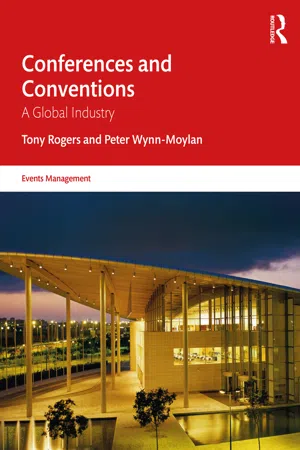
- 360 pages
- English
- ePUB (mobile friendly)
- Available on iOS & Android
About this book
Fully revised and updated to reflect current trends and emerging topics, the fourth edition of Conferences and Conventions: A Global Industry provides an expert-led, comprehensive introduction to, and overview of, the key elements of the global conference, convention and meetings industry.
This book examines the conference industry's origins, structure and future development, as well as its economic, social and environmental impacts. It provides an in-depth analysis of the strategies, practices, knowledge and skills required to organise memorable conferences and similar business events, with detailed descriptions of all the planning and operational processes. Following an international approach, this edition features additional sections on the increase in technological advancements and opportunities, as well as the rise of virtual and hybrid events in a post-pandemic era. Written in an accessible and engaging style, the book includes integrated case studies to highlight current issues and demonstrate theory in practice.
Structured logically with useful features throughout to aid learning and understanding, this book is an invaluable resource to students following events management, hospitality and tourism courses, as well as for event planners and practitioners already working in the conference industry.
Frequently asked questions
- Essential is ideal for learners and professionals who enjoy exploring a wide range of subjects. Access the Essential Library with 800,000+ trusted titles and best-sellers across business, personal growth, and the humanities. Includes unlimited reading time and Standard Read Aloud voice.
- Complete: Perfect for advanced learners and researchers needing full, unrestricted access. Unlock 1.4M+ books across hundreds of subjects, including academic and specialized titles. The Complete Plan also includes advanced features like Premium Read Aloud and Research Assistant.
Please note we cannot support devices running on iOS 13 and Android 7 or earlier. Learn more about using the app.
Information
Chapter 1 A global industry
Chapter overview
- The origins of the conference industry
- The foundations of a proper industry
- The globalisation of the conference industry
- Certain industry shortcomings
- Industry parameters and definitions
- The benefits of conferences and business events
- Threats posed by global pandemics.
- The ISBL National Virtual Conference 2020: unleashing potential (in a virtual world)
- Seoul’s innovative destination marketing in a post-COVID world
LEARNING OUTCOMES
- Explain why and how the conference industry developed in the way it did
- Understand the international dimensions of the industry and appreciate which are the most successful cities and countries
- Discuss the features of the industry that illustrate the steps still required to achieve full maturation
- Understand the key benefits afforded by conferences and business events, including their impacts and lasting legacies for organisations, attendees and local communities
- Assess the damage and threats posed to live events by pandemics and disasters and how the industry responds to these.
Introduction
The origins of the conference industry
once humans developed permanent settlements, each town or village had a public meeting area, often called a town square, where residents could meet, talk and celebrate.
- The first Continental Congress (September/October 1774), held in Philadelphia, United States, to protest the ‘Intolerable Acts’ passed by the British government in response to the Boston Tea Party of 1774
- The Quebec Conference (October 1864), held in Quebec City, Canada, leading to the creation of the Dominion of Canada
- The Paris meeting (January 1919 to January 1920), Palace of Versailles, France, which led to the Treaty of Versailles and defined the structure of post-war Europe
- The Yalta Conference (February 1945), in Livadia, Ukraine, the second of the two major wartime meetings between the ‘Big Three’: Churchill, Roosevelt and Stalin, following the Tehran conference of 1943.
Though assemblies and congresses continued to be driven by trade and industry, there was a slow and gradual increase in activity which, rather than promoting products, or reporting a company’s annual progress, looked to developing staff and sales. The precursors of the sales training meeting, the ‘congress of commercials’ (or commercial travellers) of the 1920s and 1930s, began to develop into something more modern and recognisable.
inevitable that the solicitation of these conv...
Table of contents
- Cover
- Half Title
- Series
- Title
- Copyright
- Contents
- List of figures
- List of tables
- List of boxes – case studies
- Preface
- 1. A global industry
- 2. The economic, social and environmental impacts of conferences and conventions
- 3. The structure of the conference and conventions industry
- 4. Destinations and venues
- 5. Roles in conference and convention management
- 6. Winning conference business
- 7. Designing programmes for conferences, conventions and business events
- 8. Integrating virtual attendance into face-to-face meetings
- 9. Planning for conference operations
- 10. Financial management
- 11. Conducting on-site operations
- 12. Post-event reporting
- 13. Trade shows and exhibitions
- 14. The future: Trends, challenges and opportunities
- Index